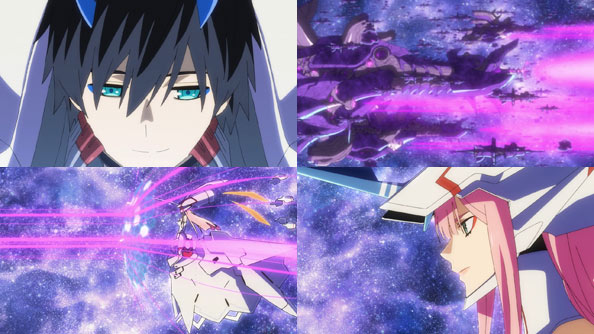
Despite the hope from their Squadmates that they’ll one day return victorious, there is every indication that Zero Two and Hiro’s insane odyssey through space is a one-way trip, at least in their current forms/lives. As they near the VIRM homeworld and fight off wave after wave of their warships, Hiro becomes a little more Zero-y, and Zero Two becomes a little more Hiro-y.

Back on Earth the gang returns to Mistilteinn, where they find things are growing again, and set to work rebuilding their food supply in order to survive without magma energy they relied on for so long. With Zero Two and Hiro’s lessons, as well as their own experiences, everyone ends up changing and growing up. Kokoro has the baby. The rejected parasites are brought out of hibernation, including Naomi.

Goro sets off on a journey of exploration on Earth seeking supplies and other lost children, making sure to kiss Ichigo before he leaves. After two years, the constant onslaught of VIRM has exhausted Hiro, allowing the enemy to “caress his consciousness” and knock him out, leaving Zero Two vulnerable.
They’re both saved not just by their own love, but by the fruits of those whom they inspired: Ai, the daughter of Kokoro and Mitsuru, named for the Japanese word for love, a word humanity had all but forgotten and which the children were never taught.

When the gang realizes the stone statute of Zero Two is a conduit through which both Zero and Hiro can hear them, they join hands and pray as loudly as they can for as long as they can, until their prayers get through to the two out in space. Hiro wakes up, green-eyed and blue-horned, rejects the pooh-poohing of the VIRM, and becomes even more one with Zero than they were before.

Apus is destroyed, but a new entity emerges; a total merging of Zero Two and Hiro, and they rend the VIRM homeworld asunder in a light that manages to reach Earth. The Klaxosaur fleets return to the earth and become one with it, and the green returns with it. Zero Two’s statue, no longer necessary, crumbles, leaving a small tree sprout.

While still hoping their friends will one day return, Squad 13 doesn’t assign them any time table, and instead begin writing their own stories. They help rebuild human civilization, without magma energy, while building families. Ikuno manages to slow their rapid aging, even though it’s too late for her. Ichigo and Goro have a kid. Futoshi finds another to love and has several kids. Zorome and Miku…continue to bicker with one another. The more things change, the more they stay the same, and all that.
Then, centuries pass, Zero Two’s cherry tree grows larger and ancient, and a huge futuristic city rises around it, only no longer hidden within a plantation dome, and no longer populated by emotionless humans. It’s in this city built by love, the thing never taught its founders, where a boy and a girl one day meet who look an awful lot like our starring pair. Circle of life, baby.
And that’s a FranXX wrap. These last few episodes sure got BIG, as in expansive in both time, scale, and theme, culminating in a resolution for all of Squad 13 and an ending a franchise like Evangelion may never give us; instead of the story stopping before it ends, the book is closed on Hiro, Zero Two, and the others, and a new story begins, built upon what they started.
The VIRM may one day return, but mankind is in a much better position to oppose them, thanks to Hiro, Zero Two, and Squad 13 not living to fight, but fighting to live…and love.





















